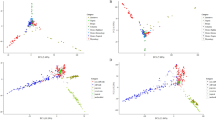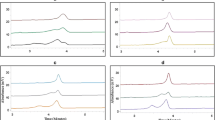Abstract
The introgression of multiple genes into traditional cultivars using marker-assisted selection (MAS) in order to obtain favorable traits is an effective strategy to achieve improved rice lines. Genotyping of markers is a central component of the evaluation of germplasm and the selection of progeny lines. However, efficient DNA extraction and genotyping of large breeding populations still remain limiting factors in rice molecular breeding programs. This study has developed and validated a cost-effective, rapid (<1 h for 96 samples), and high-throughput (96-well format) total DNA-extraction method based on magnetic particle technology. To improve the grain-quality traits of two rice varieties, we have designed and employed an efficient codominant functional marker system (including Wx, ALK, Chalk5, and fgr genes), in combination with genotyping based on automated capillary electrophoresis. Rice lines with simultaneous improvement at multiple loci were obtained and found to have superior grain quality and to be fragrant. The genotyping pipeline established in this study represents an efficient, reliable, and precise platform for MAS.



Similar content being viewed by others
References
Ahmed I, Islam M, Arshad W, Mannan A, Ahmad W, Mirza B (2009) High-quality plant DNA extraction for PCR: an easy approach. J Appl Genet 50:105–107
Andersen JR, Lubberstedt T (2003) Functional markers in plants. Trends Plant Sci 8:554–560
Ayres NM, McClung AM, Larkin PD, Bligh HFJ, Jones CA, Park WD (1997) Microsatellites and a single-nucleotide polymorphism differentiate apparent amylose classes in an extended pedigree of US rice germplasm. Theor Appl Genet 94:773–781
Bao JS, Corke H, Sun M (2006) Nucleotide diversity in starch synthase IIa and validation of single nucleotide polymorphisms in relation to starch gelatinization temperature and other physicochemical properties in rice (Oryza sativa L.). Theor Appl Genet 113:1171–1183
Batley J (2015) Plant genotyping: methods and protocols. Springer, New York
Cai XL, Wang ZY, Xing YY, Zhang JL, Hong MM (1998) Aberrant splicing of intron 1 leads to the heterogeneous 5′ UTR and decreased expression of waxy gene in rice cultivars of intermediate amylose content. Plant J 14:459–465
Calingacion M, Laborte A, Nelson A et al (2014) Diversity of global rice markets and the science required for consumer-targeted rice breeding. PLoS One 9:e85106
Chen MH, Bergman C, Pinson S, Fjellstrom R (2008) Waxy gene haplotypes: associations with apparent amylose content and the effect by the environment in an international rice germplasm collection. J Cereal Sci 47:536–545
Collins A, Ke X (2012) Primer1: primer design web service for tetra-primer ARMS-PCR. Open Bioinform J 6:55–58
Edwards K, Johnstone C, Thompson C (1991) A simple and rapid method for the preparation of plant genomic DNA for PCR analysis. Nucleic Acids Res 19:1349
Ferreira Santos RM, Vanderlei Lopes U, Clément D, Pires JL, Matos Lima E, Batista Messia T, Peres Gramacho K (2014) A protocol for large scale genomic DNA isolation for cacao genetics analysis. Afr J Biotechnol 13:814–820
Hari Y, Srinivasarao K, Viraktamath BC et al (2013) Marker-assisted introgression of bacterial blight and blast resistance into IR 58025B, an elite maintainer line of rice. Plant Breed 132:586–594
He Y, Han YP, Jiang L, Xu CW, Lu JF, Xu ML (2006) Functional analysis of starch-synthesis genes in determining rice eating and cooking qualities. Mol Breed 18:277–290
Jain SM, Brar DS, Ahloowalia BS (2010) Molecular techniques in crop improvement. Springer, New York
Jantaboon J, Siangliw M, Im-mark S, Jamboonsri W, Vanavichit A, Toojinda T (2011) Ideotype breeding for submergence tolerance and cooking quality by marker-assisted selection in rice. Field Crop Res 123:206–213
Jiang JF, Yang DB, Ali J, Mou TM (2015) Molecular marker-assisted pyramiding of broad-spectrum disease resistance genes, Pi2 and Xa23, into GZ63-4S, an elite thermo-sensitive genic male-sterile line in rice. Mol Breed 35:1–12
Jin L, Lu Y, Shao YF, Zhang G, Xiao P, Shen SQ, Corke H, Bao JS (2010) Molecular marker assisted selection for improvement of the eating, cooking and sensory quality of rice (Oryza sativa L.). J Cereal Sci 51:159–164
Kadirvel P, Senthilvel S, Geethanjali S, Sujatha M, Varaprasad KS (2015) Genetic markers, trait mapping and marker-assisted selection in plant breeding. In: Bahadur B, Venkat Rajam M, Sahijram L, Krishnamurthy VK (eds) Plant biology and biotechnology, vol II., Plant genomics and biotechnologySpringer, New Delhi, pp 65–88
Karakousis A, Langridge P (2003) A high-throughput plant DNA extraction method for marker analysis. Plant Mol Biol Rep 21:95
Li H, Li J, Cong XH, Duan YB, Li L, Wei PC, Lu XZ, Yang JB (2013) A high-throughput, high-quality plant genomic DNA extraction protocol. Genet Mol Res 12:4526–4539
Li YB, Li XH, Xiao JH, Xu CG, He YQ, Fan CC, Zhong XY, Yun P, Luo LJ, Yan B, Peng B, Xie WB, Wang GW (2014) Chalk5 encodes a vacuolar H+-translocating pyrophosphatase influencing grain chalkiness in rice. Nat Genet 46:398
Liu XL, Wan XY, Ma XD, Wan JM (2011) Dissecting the genetic basis for the effect of rice chalkiness, amylose content, protein content, and rapid viscosity analyzer profile characteristics on the eating quality of cooked rice using the chromosome segment substitution line population across eight environments. Genome 54:64–80
Luo YC, Sangha JS, Wang SH, Li ZF, Yang JB, Yin ZC (2012) Marker-assisted breeding of Xa4, Xa21 and Xa27 in the restorer lines of hybrid rice for broad-spectrum and enhanced disease resistance to bacterial blight. Mol Breed 30:1601–1610
Luo WL, Guo T, Yang QY, Wang H, Liu YZ, Zhu XY, Chen ZQ (2014) Stacking of five favorable alleles for amylase content, fragrance and disease resistance into elite lines in rice (Oryza sativa) by using four HRM-based markers and a linked gel-based marker. Mol Breed 34:805–815
Moose SO, Mumm H (2008) Molecular plant breeding as the foundation for 21st century crop improvement. Plant Physiol 147:969–977
Ni DH, Zhang SL, Chen S, Xu Y, Li L, Li H, Wang ZY, Cai XL, Li ZF, Yang JB (2011) Improving cooking and eating quality of Xieyou57, an elite indica hybrid rice, by marker-assisted selection of the Wx locus. Euphytica 179:355–362
Perez CM, Juliano BO (1978) Modification of the simplified amylose test for milled rice. Starch 30:424
Pervaiz ZH, Khaliq I, Rabbani MA, Malik SA, Turi NA (2011) A modified method for high-quality DNA extraction for molecular analysis in cereal plants. Genet Mol Res 10:1669–1673
Ramkumar G, Prahalada GD, Hechanova SL, Vinarao R, Jena KK (2015) Development and validation of SNP-based functional codominant markers for two major disease resistance genes in rice (O. sativa L.). Mol Breed 35:129
Saihua C, Yi Y, Weiwei S, Qing J, Fei H, Ziding Z, Zhukuan C, Xiangnong L, Mingliang X (2008) Badh2, encoding betaine aldehyde dehydrogenase, inhibits the biosynthesis of 2-acetyl-1-pyrroline, a major component in rice fragrance. Plant Cell 20:1850–1861
Septiningsih EM, Hidayatun N, Sanchez DL, Nugraha Y, Carandang J, Pamplona AM, Collard BCY, Ismail AM, Mackill DJ (2015) Accelerating the development of new submergence tolerant rice varieties: the case of Ciherang-Sub1 and PSB Rc18-Sub1. Euphytica 202:259–268
Shao G, Tang S, Chen M, Wei X, He J, Luo J, Jiao G, Hu Y, Xie L, Hu P (2013) Haplotype variation at Badh2, the gene determining fragrance in rice. Genomics 101:157–162
Sheng WT, Zhou LJ, Wu J, Bai B, Deng QY (2015) Evaluation of genetic effect on quality and yield traits of WXin in rice substitution lines of Y58S by marker-assisted backcross breeding. Ind J Genet Pl Br 75:114–116
Son J-S, Do VB, Kim K-O, Cho MS, Suwonsichon T, Valentin D (2014) Understanding the effect of culture on food representations using word associations: the case of “rice” and “good rice”. Food Qual Prefer 31:38–48
Sun C, Chen G, Rao YC, Zhang GH, Gao ZY, Liu J, Ju PN, Hu J, Guo LB, Qian Q, Zeng DL (2010) A simple method for rapid preparation of rice genomic DNA. Chin J Rice Sci 24:677–680
Sun WQ, Zhou QL, Yao Y, Qiu XJ, Xie K, Yu SB (2015) Identification of genomic regions and the isoamylase gene for reduced grain chalkiness in rice. PLoS One 10:e0122013
Tanksley SD (1983) Molecular markers in plant breeding. Plant Mol Biol Rep 1:3–8
Thomson MJ (2014) High-throughput SNP genotyping to accelerate crop improvement. Plant Breed Biotechnol 2:195–212
Umemoto T, Aoki N (2005) Single-nucleotide polymorphisms in rice starch synthase IIa that alter starch gelatinisation and starch association of the enzyme. Funct Plant Biol 32:763–768
Waters DLE, Henry RJ, Reinke RF, Fitzgerald MA (2006) Gelatinization temperature of rice explained by polymorphisms in starch synthase. Plant Biotechnol J 4:115–122
Xin ZG, Chen JP (2012) A high throughput DNA extraction method with high yield and quality. Plant Methods 8:1–7
Xu Y, Li ZK, Thomson MJ (2012) Molecular breeding in plants: moving into the mainstream. Mol Breed 29:831–832
Yan B, Yacouba NT, Chen J, Wang Y, Gao G, Zhang Q, Liu X, He Y (2014) Analysis of minor quantitative trait loci for eating and cooking quality traits in rice using a recombinant inbred line population derived from two indica cultivars with similar amylose content. Mol Breed 34:2151–2163
Yang YG, Kim JY, Soh M-S, Kim D-S (2007) A simple and rapid gene amplification from Arabidopsis leaves using AnyDirect system. J Steroid Biochem 40:444–447
Ye S, Dhillon S, Ke XY, Collins AR, Day IN (2001) An efficient procedure for genotyping single nucleotide polymorphisms. Nucleic Acids Res 29:88
Zhou L, Chen ZJ, Lang XY, Du B, Liu K, Yang GC, Hu G, Li SH, He GC, You AQ (2013) Development and validation of a PCR-based functional marker system for the brown planthopper resistance gene Bph14 in rice. Breed Sci 63:347–352
Acknowledgments
Financial support for this research was provided in part by a grant from Science and Technology Planning Project of Guangdong Province, China (2015B020231011), National Key Technology Research and Development Program of China (No. 2016YFD0102102), and the earmarked fund for Modern Agro-industry Technology Research System (CARS-01-12).
Author information
Authors and Affiliations
Corresponding authors
Electronic supplementary material
Below is the link to the electronic supplementary material.
Rights and permissions
About this article
Cite this article
Chen, L., Gao, W., Guo, T. et al. A genotyping platform assembled with high-throughput DNA extraction, codominant functional markers, and automated CE system to accelerate marker-assisted improvement of rice. Mol Breeding 36, 123 (2016). https://doi.org/10.1007/s11032-016-0547-y
Received:
Accepted:
Published:
DOI: https://doi.org/10.1007/s11032-016-0547-y




